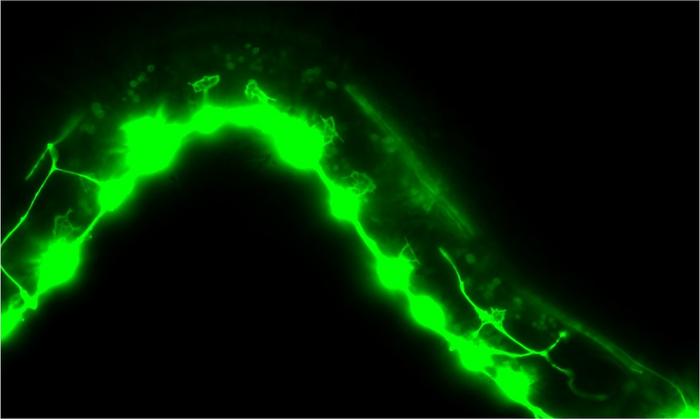LAWRENCE — Many people are familiar with oncogenes — genes long known to be involved in cancers in humans, such as the gene “Src.”

Credit: Snehal Mahadik
LAWRENCE — Many people are familiar with oncogenes — genes long known to be involved in cancers in humans, such as the gene “Src.”
What’s less widely understood is that oncogenes didn’t evolve just to cause cancer in species, but rather to control events of normal growth and differentiation.
“As an organism grows from a single fertilized egg to form all the different tissue types, these oncogenes, including Src, evolved to control these normal events,” said Erik Lundquist, professor of molecular biosciences and associate vice chancellor for research at the University of Kansas. “To understand what these oncogenes are doing in cancer, it’s important to understand what they’re doing in normal development when they’re not defective. When Src gets a mutation that causes it to be defective, it becomes an oncogene. But we’re looking at what Src does in a normal developmental context.”
Now, in new research appearing in PLOS ONE, Lundquist and colleagues from his lab at KU have added new specifics to the role Src plays in our biology, showing the gene is required for healthy development of the nervous system.
The work depended on a model organism called C. elegans, a nematode worm whose Src gene is very similar to humans — but called “SRC-1.”
“The fun thing is that by the time humans and this worm last had a common ancestor, about 600 million years ago, most of the functions of the Src protein had already been worked out in that common ancestor,” Lundquist said. “What we study about the SRC-1 protein in this model organism, the nematode worm, will be relevant to what it’s doing in human growth and development and therefore human pathogenesis and cancer.”
By using CRISPR gene editing technology in Lundquist’s lab to knock out the SRC-1 gene’s function entirely in the nematodes, the KU researchers showed the gene plays a key role in development of the nervous system by guiding axons.
“As the nervous system develops, neurons are born, and they have to elaborate these structures called axons,” Lundquist said. “Axons are the electrical wiring of the nervous system. The SRC-1 protein is involved in the normal development of these axons.
“For example, in a human context, if you have a motor neuron born in your spinal cord, how does the axon get out to your fingertip to a muscle versus to your stomach to a muscle? That’s called axon guidance. The SCR-1 protein is a key player in axon guidance, and this paper shows that.”
Lundquist’s collaborators at KU were graduate research assistant Snehal Mahadik and former undergraduate student Emily Burt.
“Snehal was a graduate student in our lab initially, did the work and received her Ph.D. a couple of years ago,” Lundquist said. “She also worked with an undergraduate student in the lab who’s also an author on the paper — Emily, who helped do a lot of the experiments and was responsible for some of the analysis. Snehal did the genome editing, but Emily did many of the surrounding experiments.”
The KU team established new details about how SRC-1 is involved in the growth of axons, finding SRC-1 regulates a cellular structure called a growth cone.
“It’s like the steering wheel of the axon that guides the axon to its target — either a motor neuron or another neuron in the nervous system — to form a synapse,” Lundquist said. “Because the axon needs to be in place for a synapse to form, the SRC-1 protein acts in axon guidance.”
Moreover, the team settled scientific debate about how SRC-1 contributes to axon guidance in normal development.
“There had been some discrepancies in the literature about the role of this gene, and we settled that by deleting it entirely — which is quite definitive,” Lundquist said. “It turns out the mutation most people were using to study SRC-1 in worms wasn’t a loss of gene function. It was an activated form of the gene, more like what an oncogene does.”
Lundquist, who also serves with the KU Cancer Center and KU Center for Genomics, said oncogenes often lose their ability to be regulated by other proteins, leading to uncontrolled activity that can cause carcinogenesis.
“The mutation in the SRC-1 gene was like this,” he said. “But we did a clean, precise knockout, ensuring the gene had no potential function in the organism. We found the phenotype (its physical appearance) was opposite of the previous mutation, confirming the previous mutation was not a loss of function but an overactive form of the gene.”
The work is the initial step in developing new therapies for spinal cord injuries and stroke, which involve neuron damage and death.
“In genetics, there are often cassettes of molecules that are reused in different events,” Lundquist said. “We’re looking at and defining a cassette that’s being used by Src in axon guidance. But that same cassette might also be involved in processes related to oncogenesis and cancer. This understanding gives us more targets for therapeutic intervention.”
The KU researcher said if scientists can understand how Src is engaging its effectors, it broadens the target for therapeutic intervention with proteins that can be specifically modified by particular pharmaceutical compounds, maybe in ways that weren’t previously appreciated. For this reason, the research was supported by the National Institutes of Health.
“That’s the bigger picture importance to biomedical research — understanding how these proteins relate to each other in this context,” he said. “There’s also the potential for repairing or alleviating the effects of stroke, hypoxia and nerve damage after stroke or spinal cord injury. Our central nervous systems do not regenerate well, so understanding how neurons normally grow might eventually help us understand how they might regrow.”
Discover more from Science
Subscribe to get the latest posts sent to your email.


